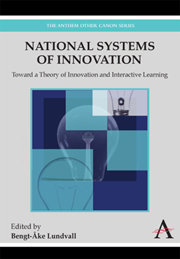Book contents
- Frontmatter
- Contents
- List of Tables
- List of Figures
- Preface
- 1 Introduction
- Part I Toward a New Approach to National Systems of Innovation
- 2 Institutional Learning
- 3 User-Producer Relationships, National Systems of Innovation and Internationalisation
- 4 Approaching National Systems of Innovation from the Production and Linkage Structure
- Part II A Closer Look at National Systems of Innovation
- Part III Opening National Systems of Innovation: Specialisation, Multinational Corporations and Integration
- Notes
- References
3 - User-Producer Relationships, National Systems of Innovation and Internationalisation
from Part I - Toward a New Approach to National Systems of Innovation
Published online by Cambridge University Press: 05 March 2012
- Frontmatter
- Contents
- List of Tables
- List of Figures
- Preface
- 1 Introduction
- Part I Toward a New Approach to National Systems of Innovation
- 2 Institutional Learning
- 3 User-Producer Relationships, National Systems of Innovation and Internationalisation
- 4 Approaching National Systems of Innovation from the Production and Linkage Structure
- Part II A Closer Look at National Systems of Innovation
- Part III Opening National Systems of Innovation: Specialisation, Multinational Corporations and Integration
- Notes
- References
Summary
Introduction
In neoclassical trade theory the so-called primary factors of production, capital and labour, are treated as strictly national assets, assumed not to cross national borders. Technology, on the other hand, is assumed to be a transnational resource, moving freely across borders. The only fundamental difference between national systems is the difference in factor proportions, and export and import specialisation reflects nothing but such differences.
One way to restate this model would be to propose a more restricted mobility of technology, and to treat investments in R&D on par with investments in factories and machinery. However, the national system of innovation would still be of very limited analytical interest in this extended model. The only new variables to be considered would be the stock and the rate of investment in R&D.
The National System of Innovation and the Fundamental Neoclassical Assumptions
In order to see, why the national system of innovation is a useful analytical concept, a more radical revision of basic neoclassical assumptions is necessary. In a world where agents are perfectly rational (maximisers of utility and profit, with unlimited access to information, and an unlimited capacity to gather and process information) and where all transactions take place in pure markets, with anonymous relationships between buyers and sellers, national borders play a limited economic role. In such a world, it is legitimate to assume that institutional and cultural differences between nations do not to interfere with economic processes.
- Type
- Chapter
- Information
- National Systems of InnovationToward a Theory of Innovation and Interactive Learning, pp. 47 - 70Publisher: Anthem PressPrint publication year: 2010
- 12
- Cited by

